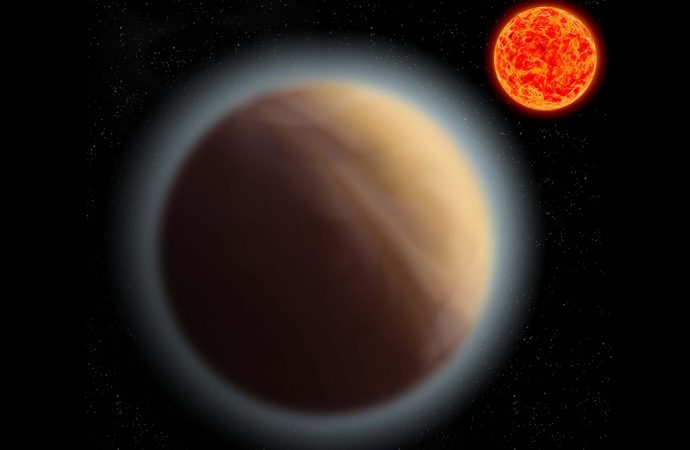An Earth-sized planet orbiting a dim star 39 light years away has a hazy atmosphere that could indicate the presence of a “water world”.
It is one of the first times astronomers have been able to detect an atmosphere surrounding a small rocky planet.
Similar observations using the next generation of powerful telescopes could be used to look for life outside the solar system.
Until now, scientists have mostly been able to spot the atmospheres of giant “hot Jupiter” exoplanets that are very unlikely to support life.
The super-Earth planet GJ 1132b was observed as it passed in front of a cool red dwarf star, blocking out some of the star’s light.
By measuring the slight drop in the star’s brightness, astronomers were able to work out that the planet was 1.4 times the size of Earth.
They also found that in one light wavelength band, the planet looked slightly bigger. This could be explained by an atmosphere that was opaque to some light wavelengths, but transparent to others.
“While this is not the detection of life on another planet, it’s an important step in the right direction,” says John Southworth at the University of Keele, who led the team.
The detection of an atmosphere around GJ 1132b marks the first time that an atmosphere has been detected around a planet less than twice the size of Earth. Previously, we had seen a waterless atmosphere around the planet 55 Cancri e, which is between 6 and 8 times Earth’s mass.
Tentative steps
“With this research, we have taken the first tentative step into studying the atmospheres of smaller, Earth-like planets,” Southworth says.
The team simulated a range of possible atmospheres for the planet, and finding that those rich in water and/or methane would explain the observations. The planet is significantly hotter and a bit larger than Earth, so one possibility is that it is a ‘water world’ with an atmosphere of hot steam, the team says.
Analysing the chemical composition of exoplanet atmospheres could in future yield tell-tale signs of life.
Ozone, derived from oxygen released by plants, is one atmospheric life marker. Methane is another, although it can also be generated by volcanic activity.
Sara Seager at the Massachusetts Institute of Technology has compiled a list of 14,000 different molecules that could provide biosignatures of life on alien worlds.
NASA’s planned James Webb Space Telescope (JWST), due to launch next year as a successor to the Hubble Space Telescope, will be powerful enough to begin studying the atmospheres of Earth-like exoplanets.
There are also proposals for an even bigger High Definition Space Telescope (HDST), with a 12-metre-wide mirror twice as large as the one carried by the JWST. It would directly image planets in nearby star systems and search for the fingerprints of life in their atmospheres.
The HDST, likely to be a multibillion-pound international project, is not expected to be launched until the 2030s.
Source: New Scientist
































Leave a Comment
You must be logged in to post a comment.